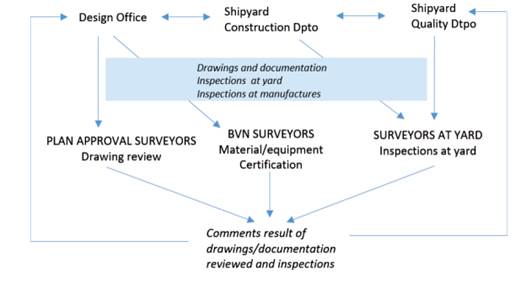Shipyard’s Quality System involvement in the classification process at the new construction phase
DOI:
https://doi.org/10.25043/19098642.245Keywords:
Quality Management System, Ship Classification Society, Classification rulesAbstract
The Quality Management System (QMS) of a shipyard is considered as a dynamic system which ameliorates in parallel with the evolution of the shipyard, having as purpose to optimize construction performance, to reduce risks, costs and time. The interaction and participation with external organizations play an important role in the cycle processes of maintenance and improvement of the Shipyard QMS. Bureau Veritas (BV) being a Ship Classification Society, contributes to the certification process through compliance with regard to BV technical rules and statutory requirements for each ship configuration. This paper illustrates the importance of the interaction between shipyard and class society starting at early design phase until delivery of the ship. Process described is based on specifics BV rules and New Building procedures which are continuously updated based on new international regulations, experiences, researches and developments. The pre-project process is founded on the definition of the scope of work, a thorough review of the contract, familiarization with the shipyard’s facilities, and the definition and agreement of all activities to be addressed throughout the entire construction. The construction process unfolds according to the agreements outlined during the pre-project phase. This part is specifically concentrated on Design Review (drawings and documents), Documentation System (procedures and methods), the Verification System (monitoring, control & reporting, witnessing, inspection & test), and the Management System (but not limited to); all of which are managed under a specific BV IT Tool. The result of all this is an efficient classification process that ensures ships remain safe, compliant, efficient, and environmentally friendly throughout their operating life.
Downloads
References
Ionel Danul SAVU, New concept of quality management in shipbuilding. Advanced Engineering Forum Vol 13, pp 332-340 (2015) https://doi.org/10.4028/www.scientific.net/AEF.13.332
IACS Homepage, Unifi ed requirements URZ23 Rev 7. https://iacs.org.uk, last accessed 2022/11/20.
Bureau Veritas, Internal Procedures for New Construction Building Version 3.12 (April 2022)
Abdulaziz A Bubshait, ISO 9000 Quality standards in Construction. Journal of Management in Engineering (1999) https://doi.org/10.1061/(ASCE)0742-597X(1999)15:6(41)

Published
How to Cite
Issue
Section
License
Copyright (c) 2023 Cotecmar

This work is licensed under a Creative Commons Attribution 4.0 International License.
The authors who publish in this Journal certify that:
- The work submitted for publication in The Ship Science and Technology journal, was written by the author, given that its content is the product of his/her direct intellectual contribution.
- All data and references to material already published are duly identified with their respective credits and are included in the bibliographic notes and quotations highlighted as such.
- All materials submitted for publication are completely free of copyrights; consequently, the author accepts responsibility for any lawsuit or claim related with Intellectual Property Rights thereof, Exonerating of responsibility to The Science and Technology for the Development of Naval, Maritime, and Riverine Industry Corporation, COTECMAR.
- In the event that the article is chosen for publication by The Ship Science and Technology journal, the author state that he/she totally transfers reproduction rights of such to The Science and Technology for the Development of Naval, Maritime, and Riverine Industry Corporation, COTECMAR.
- The authors retain the copyright and transfer to COTECMAR the right of publication and reproduction of the work which will be simultaneously subject to the Creative Commons Attribution License (CC -BY) , which allows the license to copy, distribute, display and represent the work and to make derivative works as long as it recognizes and cites the work in the manner specified by the author or licensor.
- For more information about the Creative Commons Attribution License (CC -BY) and his use and scope, please visit the following web page https://creativecommons.org/licenses/by-sa/4.0/legalcode








